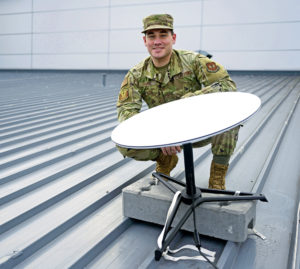
Ramstein Airmen received 15 terminals for satellite internet during Afghanistan evacuation operations, Sept. 20.
Ramstein Air Base is currently using the Starlink terminals to support the current evacuation transient hub operations where standard fiber-optic or other standard, physical internet connections are not available.
“We are using Starlink as a third party terminal to allow other units and partners outside the U.S. Air Force to access our network,” said U.S. Air Force Airman 1st Class David S. Cho, 86th Communication Squadron client systems technician. “They can use it as a commercial Wi-Fi and can use a virtual private network to gain access to (the internet).”
During Operations Allies Refuge and Operations Allies Welcome, many other units and organizations came to Ramstein to assist with the growing number of evacuees. The 86th CS helped where they could to get our partners access to U.S. Air Force systems.
“The 86 Communications Squadron provided commercial internet capabilities by using Starlink to federal agencies like the Department of Homeland Security and the Department of State,” said U.S. Air Force Capt. Hector Valladares, the 86th CS Operations flight commander. “This enables them to connect to their systems to vet and process evacuees.”
Innovation is a top priority of senior U.S. Air Force leaders. New technologies and process improvement is what the Air Force needs to stay ahead of adversaries and strengthen their allies.
“Starlink is a new capability that is currently in beta testing,” Valladares said. “It provides high-speed internet access with download speeds of up to 150 megabytes per second. It takes about 15 to 30 minutes to setup without the need for any infrastructure.”
As many who live in rural areas know, getting a wired internet connection is difficult. Ethernet cables are fragile and need to be carefully handled which is the same for the U.S. military. Certain locations can’t receive a hard-wired connection which is why the 86th CS turned to an alternative solution.
“For a few places around the base it was difficult to get internet cables to,” Cho said. “It can take days if not months sometimes to accomplish and a lot of the cables have to be run underground because they’re so delicate. So with the Starlink terminals it saved us a lot of time and work.”
The recent evacuation operations have pushed much of the existing information technology infrastructure to its limits. The 86th CS adaptability in use of new technologies and the application of them into real-world missions. In the current Afghanistan evacuation, this technology linked key inter-agency partners together which expedited the transport of vulnerable people to safe haven.


